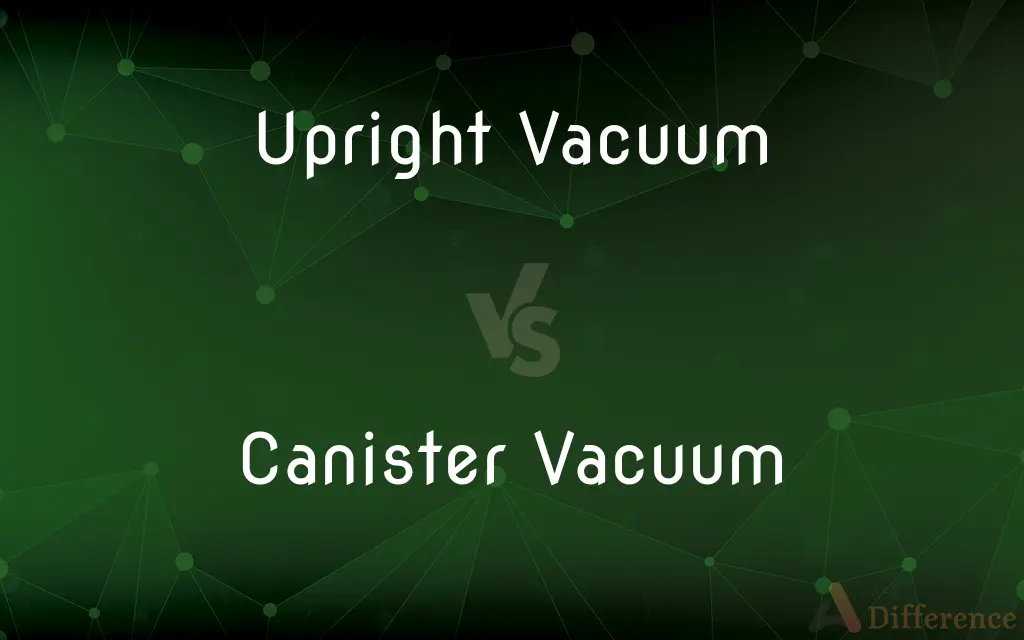Upright Vacuum vs. Canister Vacuum — What's the Difference?
By Tayyaba Rehman & Fiza Rafique — Published on February 15, 2024
Upright vacuums have a single unit with the motor and suction head in one, suitable for carpets. Canister vacuums feature a wheeled body connected to a flexible hose and wand, offering versatility and maneuverability.

Difference Between Upright Vacuum and Canister Vacuum
Table of Contents
ADVERTISEMENT
Key Differences
Upright vacuums and canister vacuums serve the same primary purpose of cleaning but differ significantly in design, functionality, and suitability for various cleaning tasks. Upright vacuums are designed as a single, tall unit where the suction head is directly attached to the motor and dustbin. This design makes upright vacuums particularly effective on carpets and rugs due to their strong suction and brush bar, which helps to agitate and lift dirt from fibers. They are generally easier to store because of their vertical design and are often preferred for their ease of use in larger, open areas.
Canister vacuums, on the other hand, feature a separate body for the motor and dust collection, connected to the suction head via a flexible hose. This design offers greater flexibility and maneuverability, making canister vacuums ideal for cleaning stairs, under furniture, and other hard-to-reach areas. They often come with a variety of attachments tailored for different surfaces, including hardwood floors, draperies, and upholstery. The wheeled body of a canister vacuum can follow you around as you clean, although dragging it can sometimes be cumbersome in tight spaces.
In terms of storage, upright vacuums stand on their own and can be easily tucked away in a closet. Canister vacuums, with their hose and wand, might require a bit more space and thoughtful organization. When it comes to weight, uprights can be heavier and harder to push, particularly on thick carpets, while canisters, being pulled behind, might be easier to handle, especially for those with mobility issues.
Maintenance and ease of cleaning can also differ. Upright vacuums often have larger dustbin capacities, requiring less frequent emptying, and their brush rolls are typically easier to access for cleaning or replacement. Canister vacuums might have smaller dustbins but offer more flexibility with interchangeable heads for different cleaning tasks.
Ultimately, the choice between an upright and a canister vacuum comes down to personal preference, the types of surfaces you need to clean, and considerations like storage space, weight, and maneuverability.
ADVERTISEMENT
Comparison Chart
Design
Single tall unit, brush and motor combined
Separate body and suction head connected by a hose
Best For
Carpets and large open areas
Varied surfaces, stairs, and under furniture
Maneuverability
Less flexible, better for straight paths
Highly maneuverable with flexible hose
Storage
Stands upright, easy to store
Requires more space due to hose and wand
Weight & Handling
Generally heavier, pushed in front of you
Lighter suction head, body is pulled behind
Compare with Definitions
Upright Vacuum
Features a foot-operated lever for tilting.
I tilted the upright vacuum to reach under the coffee table.
Canister Vacuum
Provides versatility with various attachments.
The canister vacuum came with a crevice tool for tight spaces.
Upright Vacuum
Often includes on-board attachments.
The upright vacuum's attached hose made it easy to clean curtains.
Canister Vacuum
Efficient for both hard floors and carpets.
Switching the canister vacuum's head lets me clean all floor types.
Upright Vacuum
May have adjustable height settings for different floor types.
I adjusted the upright vacuum's setting when moving from carpet to hardwood.
Canister Vacuum
Typically quieter than upright models.
The canister vacuum was so quiet, it didn't disturb the cat.
Upright Vacuum
Ideal for deep-cleaning carpets.
I use my upright vacuum weekly to keep the carpets fresh.
Canister Vacuum
Easier to use on stairs and under furniture.
Cleaning the stairs became effortless with the canister vacuum.
Upright Vacuum
A vacuum with an integrated suction head and body.
The upright vacuum stood neatly in the corner of the living room.
Canister Vacuum
A vacuum with a wheeled body and flexible hose.
I pulled the canister vacuum easily as I cleaned each room.
Common Curiosities
Which vacuum type is more affordable?
Prices vary widely, but uprights can be less expensive at entry-level.
Do canister vacuums have better suction than uprights?
Suction power varies by model, not necessarily by type.
Can I use a canister vacuum on carpets?
Yes, with the right brush attachment, canister vacuums work well on carpets.
Are upright vacuums harder to push on thick carpets?
They can be, depending on the vacuum's weight and suction power.
How do I choose between an upright and a canister vacuum?
Consider your main cleaning needs, storage space, and any physical limitations.
Do all upright vacuums stand on their own?
Most do, but some models with flexible hoses might need support.
Can canister vacuums be used for drapes and upholstery?
Yes, with the appropriate attachments, they're excellent for above-floor cleaning.
Which vacuum type is better for pet hair?
Both can be effective, but look for models with pet hair-specific attachments.
Which is better for a home with multiple floor types?
Canister vacuums offer more versatility with interchangeable heads.
Are canister vacuums better for small spaces?
Their flexibility makes them suitable, but they might need more storage space.
Are canister vacuums less noisy?
They tend to be quieter due to their separate motor bodies.
Is an upright or canister vacuum easier to maintain?
Uprights often have simpler designs, potentially making them easier to maintain.
Can I store attachments on the vacuum itself?
Many uprights feature on-board storage, while canister accessories might require separate storage.
Do upright vacuums clean edges well?
Look for models with edge-cleaning capabilities for best results.
Do either vacuum types come with HEPA filters?
Both canister and upright vacuums can feature HEPA filters for improved air quality.
Share Your Discovery

Previous Comparison
OSB vs. Plywood
Next Comparison
Skim Milk vs. Whole MilkAuthor Spotlight
Written by
Tayyaba RehmanTayyaba Rehman is a distinguished writer, currently serving as a primary contributor to askdifference.com. As a researcher in semantics and etymology, Tayyaba's passion for the complexity of languages and their distinctions has found a perfect home on the platform. Tayyaba delves into the intricacies of language, distinguishing between commonly confused words and phrases, thereby providing clarity for readers worldwide.
Co-written by
Fiza RafiqueFiza Rafique is a skilled content writer at AskDifference.com, where she meticulously refines and enhances written pieces. Drawing from her vast editorial expertise, Fiza ensures clarity, accuracy, and precision in every article. Passionate about language, she continually seeks to elevate the quality of content for readers worldwide.
















































